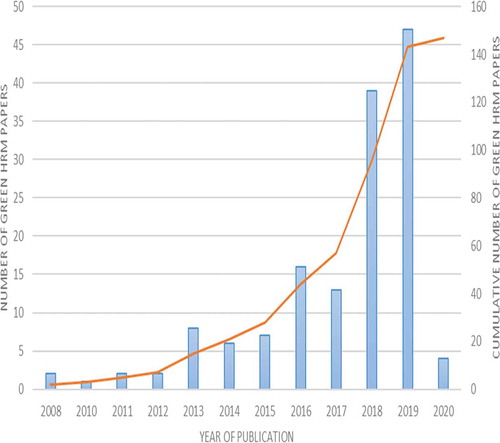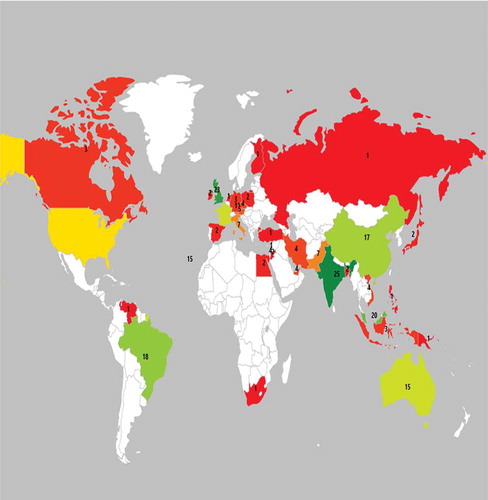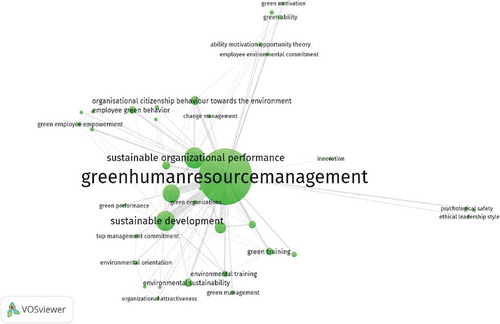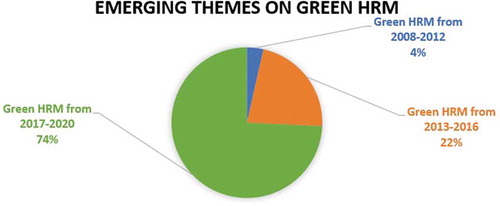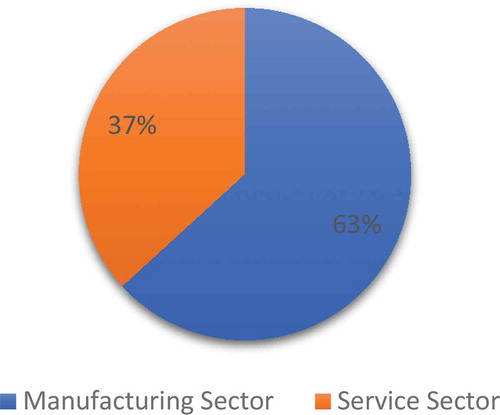Abstract
The increasing research in protecting the environment has led to the emergence of a new research paradigm in the field of human resource management (HRM). The HRM researchers are now exploring how HRM can contribute to green outcomes and invented the term “green human resource management” (GHRM). In this bibliometric analysis, 147 documents were examined on GHRM scholarship. The objective of this study was to analyze the volume, increasing trend, worldwide distribution, key journals, pioneer authors, dominating nations and dominating sectors in GHRM. For this work, six combinations of the words were merged together with logical operators, “ TITLE-ABS-KEY (“green human resource management”) OR TITLE-ABS-KEY (“green hr”) OR TITLE-ABS-KEY (“green human resource”) OR TITLE-ABS-KEY (“GHRM”) OR TITLE-ABS-KEY (“green human resource management practices”) OR TITLE-ABS-KEY (“GHRMP”), thus making the span broader. The review showed that the GHRM is still an emerging concept and this review hopes to guide modern researchers by giving an overview of the current situation.
PUBLIC INTEREST STATEMENT
Now a days Organizations are acknowledging the importance of environmental issues. Environmental issue is the eye-catching word of the 21th century that has penetrated in our lives and workplace. Our way of living both at individual and professional level started affecting the environment so badly that it is now our responsibility to address and mitigate environmental issues before things get more worse. We need to modify our way of living as well as the workplace behaviour in the organizations. For the organizations to enhance performance and mitigate environmental issues green human behaviour is imperative. Green Human Resource Management is a concept which aims in recruiting, selecting, training, developing and appraising a green workforce that is environmentally sound and acknowledge green ethnology in the organization.
1. Introduction
Countries around the world whether developing or developed are now considering the environmental issues (Gupta, Citation2015) this is because, the heavy industrial activities have depleted the environment(Jabbour & Santos, Citation2008). To overcome the issue, the safety of the environment has seemed to be one of the most substantial social preference and management in the organizations are taking curative steps(Pinzone et al., Citation2016)
Now a days an emerging area of research in which the HRM practices, procedures and policies are merged with the environmental management. For instance, according to Jabbour (Citation2013) the Green HRM is related to “systemic, planned alignment of typical human resource management practices with the organizations environmental goals”. The field of GHRM was brought to attention by few numbers of previous scholars (Jabbour & Santos, Citation2008) but the term has gained more magnetism in the recent years because the idea is shifted from purely economic to ecological and social which we call as the triple bottom line, which further puts attention on how the organizations can preserve the environment and create competitive advantage (Elkington, Citation1998). GHRM encompasses those HRM strategies that boost the sustainable use of the resources and stop any environmental harm arising from the business operations (Zoogah, Citation2011). Therefore, the concept of GHRM draws attention to establish a workforce that is environmentally sound and should be committed to the environmental issues (Masri & Jaaron, Citation2017). Because the Green HRM as an umbrella, improves the role of HRM in developing sustainability concept a reality (Kramar, Citation2014). It emphasizes that the department of HR can play a major part in the execution of environmental friendly policies (D. Renwick et al., Citation2008).
The increasing trend in the field of Green Human Resource Management, this bibliometric review puts light on the development of the literature only related to Green-HRM with the following research questions:
RQ1: What are the total number of papers, increasing trend and worldwide distribution only in the field of Green Human Resource Management in terms of developing and developed countries?
RQ2: Which are those journals and on Green HRM that have the most citation impact?
RQ3: Who are the pioneer authors in the field of Green Human Resource Management that have most citations?
RQ4: What are the related topic words in GHRM?
RQ5: What are the dominating sectors in GHRM scholarship?
2. Working definitions and GHRM overview
According to Tang et al. (Citation2018) “GHRM as a scale for credibility and development which results in employees’ green behaviour and awareness through adoption of a green perspective and making use of green communication channels”. Similarly Latan et al. (Citation2018) believe that “the functions and measures of GHRM are highly tangible and cause the green issues to be considered for, in employees’ daily tasks, and also have positive effects on employees’ lives and performances” D. W. Renwick et al. (Citation2013) says that “GHRM improves the credibility of organizations and causes the labour force to show more willingness to stay in their organizations, and also causes better labour forces to be willing towards getting recruited by green corporations”. While attempting to create the overview towards the definition of the green human resource management the concept of GHRM is dominated by the two school of thoughts. The first of thought says that GHRM is the accumulation of HRM that is recruitment, performance management, training, development, rewards and Environmental Management and strives for the environmental performance (Jabbour & de Sousa Jabbour, Citation2016; D. W. Renwick et al., Citation2013). The Second School of thought says that not only integrating the functions of HRM with the environmental management increases the environmental performance but it is necessary to change the employee attitude and behaviour towards the environment and thus leading to improved environmental performance (Ehnert, Citation2009; Taylor et al., Citation2012).
3. Why go green?
From the two school of thoughts that have been explained above it is clear that the core idea is protecting the environment. Therefore, according to the existing literature there are various reasons of linking human resource management with the environment.
Making the organizations more responsible for sustainable outcomes especially the environmental damage caused by their activities (Koberg & Longoni, Citation2019)
Motivating the employees so that the employees love to involve in the activities related to environmental management and providing the employees with opportunities to develop green abilities (D. D. Renwick et al., Citation2008; D. W. Renwick et al., Citation2013)
Enduring the environmental performance and to make sure the sustainable environmental performance for a longer period of time (Jose Chiappetta, Citation2011)
Enhancing the environmental performance by the human resource management functions like training, employee empowerment, environmental management systems of rewards (Daily et al., Citation2007)
Making eco-friendly behaviour and products to protect the natural environment (Ramus, Citation2002)
Providing the employees, the environmental management systems and train them, reward them in order to achieve organizational success (Berry & Rondinelli, Citation1998)
Protecting the natural environment i.e. global warming, climate change, energy crises and to make workplace healthier and environment friendly (Shrivastava, Citation1994)
4. Methods
In recent years the bibliometric assessment has gained much importance as it allows a detailed information about a particular topic (N. J. Van Eck & Waltman, Citation2017; White & McCain, Citation1998). This useful method was brought to attention by Garfield (Garfield, Citation1955), who said that it accumulates various mathematical tools and statistical techniques to examine and scan publications, for example, article, various books, book chapters etc. It is the process in which statistical methods are applied to explain a scientific research topic and draws attentions to the trends within the discipline (De Bakker et al., Citation2005; Bouyssou & Marchant, Citation2011). This method is new and innovative as compared to conventional framework building, Therefore, bibliometric analyses allow the reader to know about the past trends in the topic, puts light on the advancements in the topic and gives room for further research (Durieux & Gevenois, Citation2010).
4.1. Choosing the database
The initial stage in the bibliometric analysis is to locate for the databases that would be supportive for the purpose of the research. Consequently, data sources must be reliable and appropriate to complete the analysis and to make fine choices (Rueda et al., Citation2007). The ISI, google scholar, WOS and Scopus databases are reliable and also up to date. Our study was conducted in the Scopus Index, the most prominent databases used by the researchers globally.
4.2. Scope of search
The scope of this bibliometric analysis includes studies only on Green Human Resource Management. We only gave attention to those studies that focused explicitly on Green Human resource Management and excluded the related topics such as leadership management, strategic management, change management, innovation management, sustainable management and knowledge management. We also removed those studies that did not specifically address the GHRM. For instance, studies that used the word “green” as a buzzword without specifying green human resource management approach were not merged in the study.
4.3. Search criteria
The search of the articles only related to the green human resource management was employed with six different combinations. In the advance search option, the six combination of the words were merged together with logical operators, “ TITLE-ABS-KEY (“green human resource management”) OR TITLE-ABS-KEY (“green hr”) OR TITLE-ABS-KEY (“green human resource”) OR TITLE-ABS-KEY (“GHRM”) OR TITLE-ABS-KEY (“green human resource management practices”) OR TITLE-ABS-KEY (“GHRMP”). Upon entering this sting, the system showed 151 documents related to GHRM. After this step, we thoroughly studied the abstracts of all the documents, excluding unrelated documents and the final figure came was 147.
4.4. Measurement
For analysis VOS viewer software was used because it examines the relations between the most cited authors, collaboration between the different authors, coordination among countries, institutions, keywords, and related knowledge to the topic (Hoppen & de Souza Vanz, Citation2016). This software is also used for cluster analysis by picturing of geographical network maps through a matrix which tells bunch of co-authorship and co-occurrence (N. Van Eck & Waltman, Citation2009)
5. Results
The outcomes are presented with respect to the five objectives discussed above.
5.1. Total number of papers, increasing trend and worldwide distribution in the field of green human resource management in terms of developing and developed countries
From 2008 to the present, the total number of documents in the Scopus data base that were related to green human resource management were 147. These were 105 articles, 13 conference papers, 12 review papers, 10 book chapters, 1 book, 1 conference review, and 4 were from other sources. Figure shows the trajectory graph of the GHRM scholarship.
The above graph is giving an interesting information regarding the concept of green human resource management. From 2008 to 2020 there are variations regarding the number of papers but the idea gained too much importance in the eyes of the scholars in 2019, 2018, 2016. Out of 147 papers, 102 papers were published in these years. This increasing trend of graph tells that Green HR is still a developing concept because of the sudden increase in the literature.
The heat map in the Figure shows that knowledge generation in the field of GHRM is dominated by United Kingdom (23), China (17), Australia and France both (15), United States (11), followed by Italy (7), Austria (5), Czech Republic (4), United Arab Emirates (4), Canada(3), Germany(3), Japan (2), Poland (2), Spain (2), Ireland (2), Netherlands (1), Turkey (1), Finland (1) in terms of developed countries. Out of 147 documents these countries produced 119 documents which 80% of the total documents. India dominates in developing countries producing 25 documents, followed by Malaysia (20), Brazil (18), Pakistan (7), Iran, Vietnam and Palestine (4), Indonesia (3), Thailand (3), Bangladesh (2), While Egypt, Russia, Lebanon, Sri-Lanka, Jordan, Philippines, South Africa and Venezuela shares only one document. The developing countries produced 101 documents which is 68% of the total documents produced. Therefore, the developed countries are dominating the developing countries in producing literature related to GHRM. These findings are in line with the overall trend of research in the field of management in which the leading societies are the American and European followed by the emerging Asian societies (Gantman et al., Citation2015).
5.2. Analysis of influential journals having highest citation impact
The second objective was to determine the influential journals, documents produced and their citation impact. The 15 most highly cited journals produced 57 documents representing 38% of the total span of the documents. The distribution of the documents in these journals gave further information relating to the academic impact in the field of GHRM. Table 1 shows ranking of the journals in relation to the citation impact. The concept of Green Human Resource Management seems to be published in variety of journals. While most of the literature published in the domain of business and management, however the journal of cleaner production has the highest citation impact among all other journals, this shows that the core perspective of the term GHRM is environmental protection. The term GHRM has also been discussed in the journals like decision sciences, arts and humanities, social sciences again this shows the multifaceted nature of the GHRM Scholarship. Table elaborates the most cited journals in the field of GHRM.
Table 1. Top 15 journals publishing GHRM scholarship ranked by Scopus
5.3. Pioneer authors in GHRM scholarship
Another advantage of bibliometric study is that it tells about the prominent authors in that particular field (McCain, Citation1990; Nerur et al., Citation2008; White & McCain, Citation1998). The most prominent contributor in the field of GHRM in terms of Scopus documents between 2008 and 2020 is Jabbour having 21 documents, followed by Renwick 7, Guerci 6, Yusliza 5, Pham and Chaudhary 4. In terms of overall Scopus citations, the most eye-catching researchers in the GHRM literature are Jabbour, Renwick, Redman, De Sousa Jabbour and Guerci. Therefore, if we analyze only few scholars in the table are among the top scholars in the field of GHRM, which supports our argument that GHRM is still an emerging concept. Table shows the pioneer authors in GHRM scholarship.
Table 2. Top 12 pioneer authors on GHRM scholarship ranked by Scopus
Till now the most prominent and the most dominant researcher in the field of GHRM in terms of articles and in terms of overall Scopus citations is Jabbour. His contributions in the field of green human resource management mainly focus on the integration of HRM and Environmental Management in the firms (Jabbour & de Sousa Jabbour, Citation2016; Jabbour & Santos, Citation2008; Jackson et al., Citation2011). The authors that dominate the GHRM literature after Jabbour are Renwick, D.W.S, Redman, T., De Sousa Jabbour, A.B.L. The contributions of Renwick, Jabbour, De Sousa Jabbour and Redman mainly focus of HRM aspects of sustainable environment (Jabbour & de Sousa Jabbour, Citation2016; Jackson et al., Citation2011; D. W. Renwick et al., Citation2016).
5.4. Topic words in GHRM and emerging themes in GHRM
Based on network visualization mode in VOS viewer, Figure shows the most recurrent topics in the field of Green HR. We can see that there are some large nodes that characterize the main terms or topic that shape this field: sustainable development, sustainable organizational performance, Green organizations and GHRM.
However, it should be noted that some topics that are in the developing phase and they are gaining more attention although the size of their node is not too large, this also represents the niche area (Figure ). These topics are employee green behaviour, green employee empowerment, environmental orientation, green training and top management commitment.
Similarly, the author also observed the emerging themes on Green HRM scholarship. The author divided the articles into 3 phases for every 4 years from 2008 to 2012, 2013 to 2016 and 2017 to 2020. In the initial years on Green HRM from 2008 to 2012 which represents 4 percent of the total span of the documents the emerging themes were the greening of HR functions, green performance and making green organizations through green HRM, merging HR dimensions with the environmental management, emphasized the importance of sustainability from the HRM aspects and organizational culture and organizational learning in terms of green aspects. The middle years from 2013 to 2016 which shows 22 percent of the total documents emphasized on the role of environmental training, importance of socially responsible firms, implementation of environmental management systems, benefits of Green HRM beyond financial outcomes, studying organizational citizenship behavior for the environment in relation to Green HRM, proposing to go green in every step of human resource process and green movements in organizations to safeguard the environment. Finally, the pioneer years from 2017 to 2020, which represents 74 percent of the total span of the articles on green HRM scholarship emphasized on green innovations in the organizations, change management in relation to green aspects, green leadership, sustainable development, employee safety at workplace, and employee green behavior, moreover till now in 2020, emerging trends on green HRM Scholarship on which more concentration is required is linking how green HRM transforms the attitude of employees into green attitudes, connecting green HRM practices with green employee empowerment, green teams and more specially an environmental centered top management, role of industry 4.0 and green HRM to improve social performance as well as environmental performance (Figure ).
5.5. Contributing sectors in GHRM
After thoroughly studying the data from the Scopus database, studies conducted on the GHRM scholarship were divided into two major sectors of the economy i.e. manufacturing sector and the service sector. The dominating sector on GHRM scholarship was the manufacturing sector on which 63 percent of the studies were conducted during the period of 2008 to 2020 and merely 37 percent of the studies were conducted on service sector (Figure ). This shows that more studies are needed in service sector on GHRM scholarship. The justification to conduct studies in service sector is that an important contributor to the economy, having direct effect on GDP, job creation, traditional and new export opportunities. The service sectors like health and education are vital in achieving social and environmental objectives (Cali, Citation2008)
6. Discussion
This study put light on bibliometric analysis on GHRM scholarship between 2008 and 2020, according to the information available on Scopus database. Our paper provides a comprehensive overview of the studies conducted on GHRM to determine the research trends and popular issues. Therefore, this study presents a direction to those scholars who are interesting to study GHRM, plus this study provides past information, the present scenario and upcoming advancements in the field of green human resource management in order to develop conceptual and theoretical models.
The paper also presents the trends analysis of the GHRM scholarship in which 2019, 2018 and 2016 were the pioneer years. Moreover, we also detected the recent topics that should be linked to GHRM like green empowerment, top management commitment, sustainable development, environmental management and green training.
The studies were mainly conducted in the western regions of the world, although developing countries are also making their efforts by adding to the body of knowledge. More coordination between the countries will give the overall picture of the GHRM scholarship.
Although the main foundation of GHRM is lying on business and management domain but core theme of GHRM is to protect the environment, therefore, environment-related journal like “journal of cleaner production” possessed the highest citation impact.
Finally, the trend demonstrates a shortage of studies in the service sector. Specifically, only 37 percent of the studies were conducted in the service sector, whereas manufacturing is far ahead from the service sector, therefore to advance the GHRM scholarship service sector should be addressed.
Our study also shows that research on GHRM is relatively new and its foundations are in business and management but its roots of literature are related to environmental science.
7. Conclusions, limitations and future research
The field of green human resource management has obtained enormous growth since 2008, especially in the past few years, which has made high impact on the literature. Conclusively, GHRM is a topic that has been developed recently and currently encompasses great importance for industry and academia. There is heterogeneity in numbers on studying GHRM in developing and developed world as well as in manufacturing and service sector, therefore cross-cultural studies and multi sector studies should be conducted.
Yet, the results explained above are subjected to some limitations. First, this research is lying on the documents published in Scopus. Secondly, the problem of different researchers with the same names is also a problem in this method. Thirdly, this should be kept in mind that this study has been developed with specific field: green human resource management. Therefore, the other researchers should be prudent about the generalizability of these results.
For further studies, researchers can consider a bibliometric analysis using other databases like google scholar and Web of Science which will add more information regarding this field. Further studies should also conduct on finding the relationships between different variables in the field of GHRM using sociograms.
Acknowledgement
The authors wish to thank Azman Hashim International Business School.
Additional information
Funding
Notes on contributors
Muhammad Hamza Khan
Engr. Muhammad Hamza Khan is a PhD research scholar in the field of management at the University Teknologi Malaysia. He holds a bachelor degree in Environmental Engineering from University of Engineering and Technology Taxila Pakistan and Master’s degree in Management from Bahauddin Zarkiya University Pakistan. He is also a member of Pakistan Engineering Council. His research interest includes environmental management, sustainability issues in organizations, sustainable human resource management and sustainable organizational performance.
Syaharizatul Noorizwan Muktar
Dr. Syaharizatul Noorizwan Muktar is a Senior Lecturer at Azman Hashim International Business School (AHIBS), Universiti Teknologi Malaysia (UTM). She started her academic career with UTM in May, 2000. She has received her Ph.D in Knowledge Management & Organisation Studies from Nottingham Business School, Nottingham Trent University, UK. Her research domain includes Knowledge Management, HRM and Organisational Analysis related area using qualitative techniques.
References
- Berry, M. A., & Rondinelli, D. A. (1998). Proactive corporate environmental management: A new industrial revolution. Academy of Management Perspectives, 12(2), 38–12. https://doi.org/doi:10.5465/ame.1998.650515
- Bouyssou, D., & Marchant, T. (2011). Ranking scientists and departments in a consistent manner. Journal of the American Society for Information Science and Technology, 62(9), 1761–1769. https://doi.org/10.1002/asi.21544
- Cali, M. (2008). The contribution of services to development and the role of trade liberalisation and regulation. Overseas Dev’t Institute.
- Daily, B. F., Bishop, J. W., & Steiner, R. (2007). The mediating role of EMS teamwork as it pertains to HR factors and perceived environmental performance. Journal of Applied Business Research (JABR), 23(1), 95. https://doi.org/doi:10.19030/jabr.v23i1.1411
- De Bakker, F. G., Groenewegen, P., & Den Hond, F. (2005). A bibliometric analysis of 30 years of research and theory on corporate social responsibility and corporate social performance. Business & Society, 44(3), 283–317. https://doi.org/doi:10.1177/0007650305278086
- Durieux, V., & Gevenois, P. A. (2010). Bibliometric indicators: Quality measurements of scientific publication. Radiology, 255(2), 342–351. https://doi.org/doi:10.1148/radiol.09090626
- Ehnert, I. (2009). Sustainable human resource management. A Conceptual and Exploratory Analysis from A Paradox Perspective, 1. Heidelberg. https://doi.org/doi:http://hdl.handle.net/2078/116458
- Elkington, J. (1998). Partnerships from cannibals with forks: The triple bottom line of 21st‐century business. Environmental Quality Management, 8(1), 37–51. https://doi.org/10.1002/tqem.3310080106
- Gantman, E. R., Yousfi, H., & Alcadipani, R. (2015). Challenging Anglo-Saxon dominance in management and organizational knowledge. Revista De Administração De Empresas, 55(2), 126–129. https://doi.org/doi:http://dx.doi.10.1590/S0034-759020150202
- Garfield, E. (1955). Citation indexes for science. Science, 122(3159), 108–111. https://doi.org/doi:https://www.jstor.org/stable/1749965
- Gupta, R. S. N. (2015). Green HRM: An innovative approach to environmental sustainability [Paper Presented]. Twelfth AIMS International Conference on Management, INDIA.
- Hoppen, N. H. F., & de Souza Vanz, S. A. (2016). Neurosciences in Brazil: A bibliometric study of main characteristics, collaboration and citations. Scientometrics, 109(1), 121–141. https://doi.org/doi:10.1007/s11192-016-1919-0
- Jabbour, C. J. C. (2013). Environmental training in organisations: From a literature review to a framework for future research. Resources, Conservation and Recycling, 74, 144–155. https://doi.org/10.1016/j.resconrec.2012.12.017
- Jabbour, C. J. C., & de Sousa Jabbour, A. B. L. (2016). Green human resource management and green supply chain management: Linking two emerging agendas. Journal of Cleaner Production, 112(3), 1824–1833. https://doi.org/doi:10.1016/j.jclepro.2015.01.052
- Jabbour, C. J. C., & Santos, F. C. A. (2008). Relationships between human resource dimensions and environmental management in companies: Proposal of a model. Journal of Cleaner Production, 16(1), 51–58. https://doi.org/doi:10.1016/j.jclepro.2006.07.025
- Jackson, S. E., Renwick, D. W., Jabbour, C. J., & Muller-Camen, M. (2011). State-of-the-art and future directions for green human resource management: Introduction to the special issue. German Journal of Human Resource Management, 25(2), 99–116. https://doi.org/doi:10.1177/239700221102500203
- Jose Chiappetta, J. C. (2011). How green are HRM practices, organizational culture, learning and teamwork? A Brazilian study. Industrial and Commercial Training, 43(2), 98–105. https://doi.org/doi:10.1108/00197851111108926
- Koberg, E., & Longoni, A. (2019). A systematic review of sustainable supply chain management in global supply chains. Journal of Cleaner Production, 207, 1084–1098. https://doi.org/doi:10.1016/j.jclepro.2018.10.033
- Kramar, R. (2014). Beyond strategic human resource management: Is sustainable human resource management the next approach? The International Journal of Human Resource Management, 25(8), 1069–1089. https://doi.org/doi:10.1080/09585192.2013.816863
- Latan, H., Chiappetta Jabbour, C. J., Lopes de Sousa Jabbour, A. B., Wamba, S. F., & Shahbaz, M. (2018). Effects of environmental strategy, environmental uncertainty and top management’s commitment on corporate environmental performance: The role of environmental management accounting. Journal of Cleaner Production, 180, 297–306. https://doi.org/doi:10.1016/j.jclepro.2018.01.106
- Masri, H. A., & Jaaron, A. A. M. (2017). Assessing green human resources management practices in palestinian manufacturing context: An empirical study. Journal of Cleaner Production, 143, 474–489. https://doi.org/doi:10.1016/j.jclepro.2016.12.087
- McCain, K. W. (1990). Mapping authors in intellectual space: A technical overview. Journal of the American Society for Information Science, 41(6), 433–443. https://doi.org/doi:10.1002/(SICI)1097-4571(199009)41:6<433::aid-asi11>3.0.CO;2-Q
- Nerur, S. P., Rasheed, A. A., & Natarajan, V. (2008). The intellectual structure of the strategic management field: An author co‐citation analysis. Strategic Management Journal, 29(3), 319–336. https://doi.org/10.1002/smj.659
- Pinzone, M., Guerci, M., Lettieri, E., & Redman, T. (2016). Progressing in the change journey towards sustainability in healthcare: The role of ‘Green’ HRM. Journal of Cleaner Production, 122, 201–211. https://doi.org/doi:10.1016/j.jclepro.2016.02.031
- Ramus, C. A. (2002). Encouraging innovative environmental actions: What companies and managers must do. Journal of World Business, 37(2), 151–164. https://doi.org/doi:10.1016/S1090-9516(02)00074-3
- Renwick, D., Redman, T., & Maguire, S. (2008). Green HRM: A review, process model, and research agenda. University of Sheffield Management School Discussion Paper, 1, 1–46.
- Renwick, D. W., Jabbour, C. J., Muller-Camen, M., Redman, T., & Wilkinson, A. (2016). Contemporary developments in Green (environmental) HRM scholarship. Taylor & Francis.
- Renwick, D. W., Redman, T., & Maguire, S. (2013). Green human resource management: A review and research agenda. International Journal of Management Reviews, 15(1), 1–14. https://doi.org/doi:10.1111/j.1468-2370.2011.00328.x
- Rueda, G., Gerdsri, P., & Kocaoglu, D. F. (2007). Bibliometrics and social network analysis of the nanotechnology field [Paper Presented]. PICMET’07-2007 Portland international conference on management of engineering & technology, USA.
- Shrivastava, P. (1994). CASTRATED environment: GREENING organizational studies. Organization Studies, 15(5), 705–726. https://doi.org/doi:10.1177/017084069401500504
- Tang, G., Chen, Y., Jiang, Y., Paille, P., & Jia, J. (2018). Green human resource management practices: Scale development and validity. Asia Pacific Journal of Human Resources, 56(1), 31–55. https://doi.org/doi:10.1111/1744-7941.12147
- Taylor, S., Osland, J., & Egri, C. P. (2012). Guest editors’ introduction: Introduction to HRM’s role in sustainability: Systems, strategies, and practices. Human Resource Management, 51(6), 789–798. https://doi.org/10.1002/hrm.21509
- Van Eck, N., & Waltman, L. (2009). Software survey: VOSviewer, a computer program for bibliometric mapping. Scientometrics, 84(2), 523–538. https://doi.org/10.1007/s11192-009-0146-3
- Van Eck, N. J., & Waltman, L. (2017). Citation-based clustering of publications using CitNetExplorer and VOSviewer. Scientometrics, 111(2), 1053–1070. https://doi.org/doi:10.1007/s11192-017-2300-7
- White, H. D., & McCain, K. W. (1998). Visualizing a discipline: An author co‐citation analysis of information science, 1972–1995. Journal of the American Society for Information Science, 49(4), 327–355. https://doi.org/doi:10.1002/(SICI)1097-4571(19980401)49:4<327::aid-asi4>3.0.CO;2-4
- Zoogah, D. B. (2011). The dynamics of green HRM behaviors: A cognitive social information processing approach. German Journal of Human Resource Management, 25(2), 117–139. https://doi.org/doi:10.1177/239700221102500204

